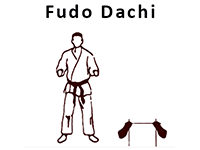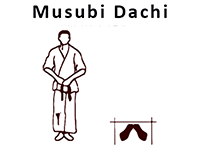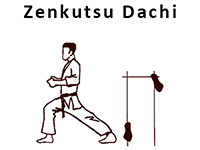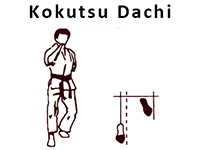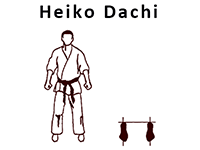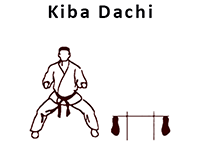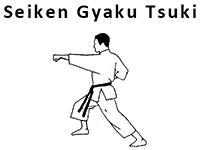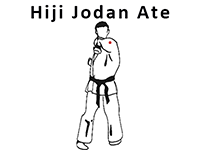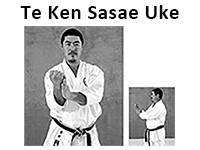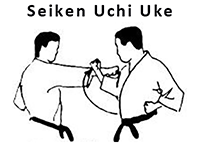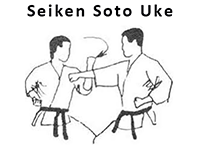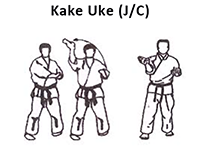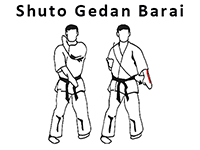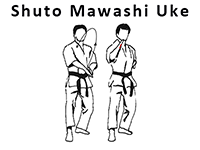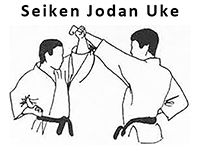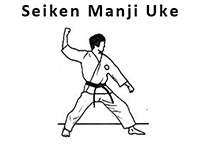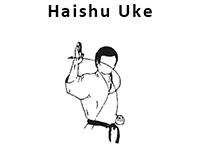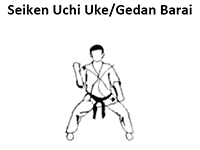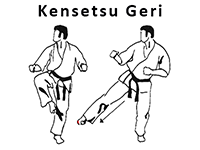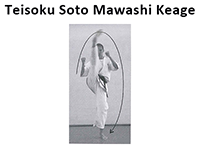|
Begin the Kata in FUDO DACHI. Move into MUSUBI DACHI and MOKUSO on the command MOKUSO.
On the next command Bassai Dai, open eyes, move into the BASSAI DAI no KAMAE position (HEISOKU DACHI and right fist in left open hand).
This is the traditional opening of the Okinawan and Shotokan version. |
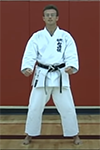 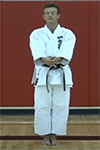  |
| 1. |
On the command HAJIME/ICHI jump forward into right KOSA ASHI DACHI (left foot behind the right) and block right Te MOROTE UCHI UKE.
TE MOROTE = supported with open hand. |
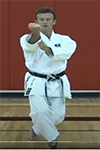 |
| 2. |
First turn your head to the left and then turn arround 180° counterclockwise into left ZENKUTSU DACHI and block left SEIKEN OI UCHI UKE, pull back the left foot (HIKI ASHI) into left KOKUTSU DACHI, and block right SEIKEN GYAKU UCHI UKE.
HIKI ASHI = Retreating leg. |
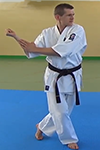 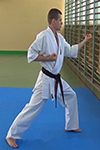 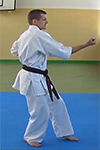 |
| 3. |
Turn 180° clockwise into right ZENKUTSU DACHI and block left SEIKEN GAYKU SOTO UKE, pull back the right foot (HIKI ASHI) into right KOKUTSU DACHI and block right SEIKEN OI UCHI UKE. |
 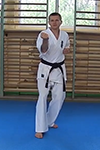 |
| 4. |
Move the right foot 90° clockwise into right ZENKUTSU DACHI, while making a deep right SEIKEN OI UCHI UKE sweep that proceeds into right SEIKEN OI SOTO UKE block (this move is a leg sweeping technique, the right fist goes circular from downward to upward into SOTO UKE), pull back the right foot (HIKI ASHI) into right KOKUTSU DACHI and block left SEIKEN GAYKU UCHI UKE. |
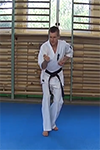 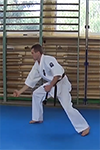 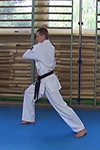 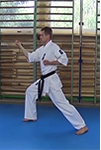 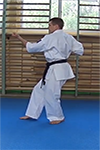 |
| 5. |
Turn 90° counterclockwise into HEIKO DACHI and go into right SEIKEN WAKI KAMAE. Make a slow left JODAN KAKE UKE.
WAKI KAMAE = Side or flank posture or stance, derived from KENDO (one of the five stances). |
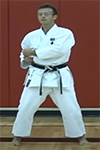 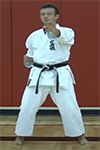 |
| 6. |
Punch right SEIKEN CHUDAN TSUKI, followed by a right SUKUI UKE.
SUIKE UKE = a scooping block (like UCHI UKE), while simultaneously turning the hips from KIBA DACHI or HEIKO DACHI into ZENKUTSU DACHI at 45°°. |
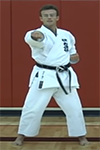 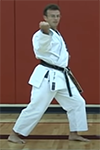 |
| 7. |
Punch left SEIKEN CHUDAN TSUKI, followed by a left SUKUI UKE. |
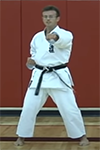 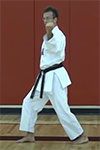 |
| 8. |
Step forward into right KOKUTSU DACHI and block right SHUTO GEDAN BARAI, left open hand in front of SUIGETSU (1).
SUIGETSU = Solar Plexus. |
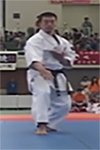 |
| 9. |
Step forward into left KOKUTSU DACHI and block left SHUTO GEDAN BARAI, right open hand in front of SUIGETSU (2). |
 |
| 10. |
Step forward into right KOKUTSU DACHI and block right SHUTO GEDAN BARAI, left open hand in front of SUIGETSU (3). |
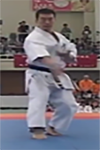 |
| 11. |
Move back with a small jump into left KOKUTSU DACHI and slowly come into SHUTO KUMITE no KAMAE. |
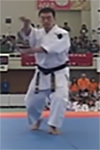 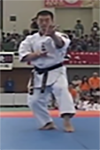 |
| 12. |
Pivot on the left leg, step in and kick a right MAE KANSETSU GERI with KIAI, pull up the right leg, place the right foot on the ground in front of you and turn 180° counterclockwise into a left KOKUTSU DACHI, together with a half left SHUTO MAWASHI UKE. |
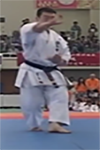 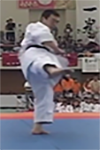  |
| 13. |
Move forward into right KOKUTSU DACHI, and block right SHUTO MAWASHI UKE. |
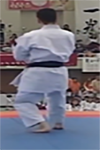 |
| 14. |
Move back into MOSUBI DACHI and bring both fists above the head in MOROTE JODAN UKE (knuckels both hands together). |
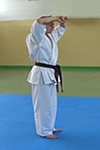 |
| 15. |
Move the left foot forward into left ZENKUTSU DACHI and strike MOROTE TETTSUI UCHI on both sides of your opponant's head (look like a double SOTO UKE) and then move forward into right ZENKUTSU DACHI striking SEIKEN CHUDAN OI TSUKI. |
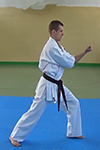 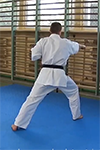 |
| 16. |
Turn your head to the left and move the left foot across and turn the hips 180° counterclockwise into ZENKUTSU DACHI blocking a right URA KOTE GEDAN UKE to the groin, and immediately turn the hips back, 90° clockwise, into KIBA DACHI, and block MANJI UKE and keep the head facing the direction of the opponent at the left.
URA KOTE = the base of the forearm, the part closest to the elbow.
MANJI UKE = a double block where one arm executes a downward block to one side, GEDAN BARAI, and the other arm executes a high-section inside forearm block, or upward back fist strike, AGE UKE or AGE TSUKI. |
 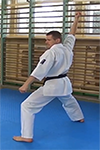 |
| 17. |
Block with the right leg TEISOKU MAWASHI SOTO KEAGE (the leg block is executed as if being attacked from behind and bring the right hand in position to strike and the right leg to stamp), turning 180° counterclockwise, pivoting on the left foot, then stamp a right YOKO FUMIKOMI GERI into KIBA DACHI and strike right TETTSUI GEDAN UCHI with KIAI.
Quickly prepare for a for a blocking movement ending at 180° counterclockwise by bringing the left open hand in the right armpit under the right fist to the left. Then slowly bring the left hand slowly under the right arm pit and block a left HAISHU UKE at approximately head height, simultaneously pulling the right hand back into HIKITE (your head follows the direction and speed of the block).
FUMIKOMI GERI = heel stamping kick. |
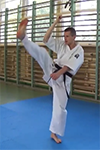 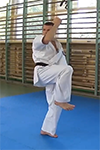 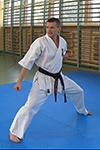 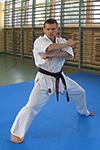 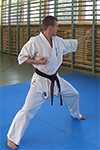 |
| 18. |
Kick a hard and fast right TEISOKU MAWASHI SOTO KEAGE on your left open hand while turning the body 90° counterclockwise. Continue turning the body 90° counterclockwise, striking the left open hand with a right HIJI JODAN ATE. Continue the turning movement (180° in total) into KIBA DACHI and block a left SEIKEN UCHI UKE – GEDAN BARAI. |
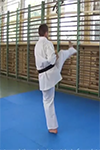 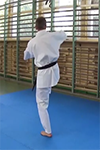 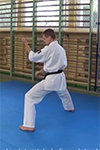 |
| 19. |
Block a right SEIKEN UCHI UKE – GEDAN BARAI followed by a left SEIKEN UCHI UKE – GEDAN BARAI. |
 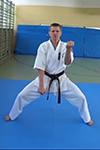 |
| 20. |
Move back into MOSUBI DACHI, and left SEIKEN WAKI KAMAE (to the right ready punch position with the right fist in the TETTSUI position on top of the left fist). |
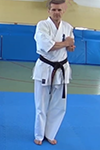 |
| 21. |
Turn with the right foot, 90° clockwise, into right ZENKUTSU DACHI and punch left YAMA TSUKI (left fist JODAN, right fist CHUDAN).
YAMA TSUKI = wide U-Punch (Mountain punch), simultaneously with both fists.
Heiko Tsuki = Parallel Punch; Yama Tsuki = mountain, wide U-punch; Awase Tsuki = U-punch. |
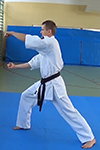 |
| 22. |
Move the right foot back into MOSUBI DACHI, and right SEIKEN WAKI KAMAE. |
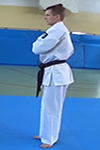 |
| 23. |
Step with the left foot forward into left ZENKUTSU DACHI and punch right Yama TSUKI. |
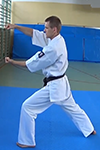 |
| 24. |
Move the left foot back into MOSUBI DACHI, and left SEIKEN WAKI KAMAE. |
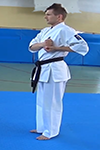 |
| 25. |
Step with the right foot forward into right ZENKUTSU DACHI and punch left Yama TSUKI. |
 |
| 26. |
Move across your back left foot, turning 270° counterclockwise, into left ZENKUTSU DACHI, making right SUKUI UKE (while turning, left hand covering your face, making a right circular scooping SEIKEN UCHI UKE to the front, and left closing hand in HIKITE). |
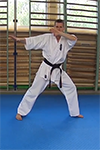 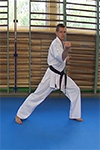 |
| 27. |
Turn to the right, 180° clockwise, into right ZENKUTSU DACHI, making left SUKUI UKE (right hand covering your face, making a left circular scooping SEIKEN UCHI UKE to the front, and right closing hand in HIKITE). |
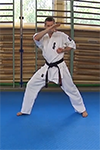 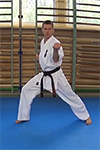 |
| 28. |
Move forward with left foot, 45° counterclockwise, left MAE FUMI ASHI into right KOKUTSU DACHI, making a right SHUTO MAWASHI UKE.
MAE FUMI ASHI = normal step forward. |
 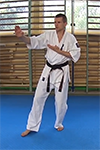 |
| 29. |
Move right foot, 90° clockwise, into right KOKUTSU DACHI, making a right SHUTO MAWASHI UKE. |
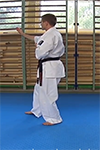 |
| 30. |
Turn your head 180° counterclockwise and make a right USHIRO KOSA ASHI (right behind left) into left KOKUTSU DACHI, making a left SHUTO MAWASHI UKE with KIAI.
USHIRO KOSA ASHI = backwards crossover step. |
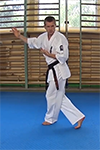 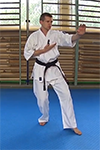 |
| 31. |
Move the left foot back, turning 45° clockwise, into HEISOKU DACHI and retain the Bassai dai no KAMAE position. |
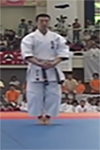 |
|
The Kata is completed on the command NAORE by moving into MOSUBI DACHI and the hands changing towards the MOKUSO position is retained.
At the command YASMEE the FUDO DACHI position is taken to relax and at ease.
Back to Top |
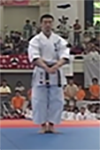 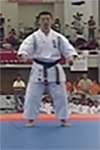 |






























































